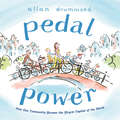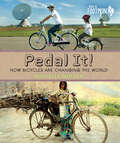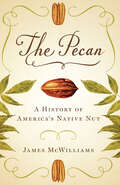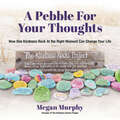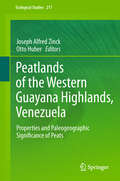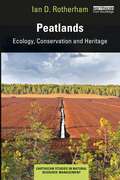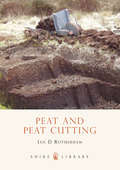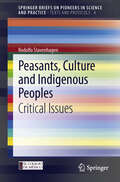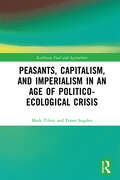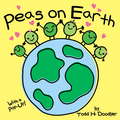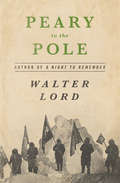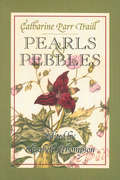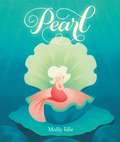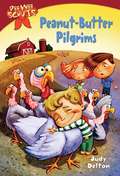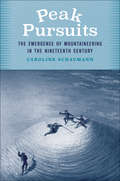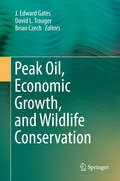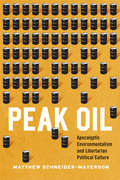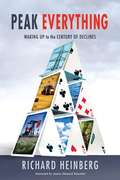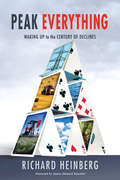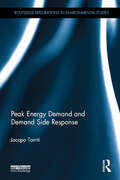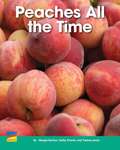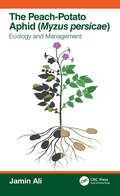- Table View
- List View
Pedal Power: How One Community Became the Bicycle Capital of the World (Green Power)
by Allan DrummondCycling rules the road in Amsterdam today, but that wasn't always the case. In the 1970's, Amsterdam was so crowded with vehicles that bicyclists could hardly move, but moms and kids relied on their bicycles to get around the city. PEDAL POWER is the story of the people who led protests against the unsafe streets and took over a vehicles-only tunnel on their bikes, showing what a little pedal power could do! Author and illustrator Allan Drummond returns with the story of the people that paved the way for safe biking around the world.
Pedal It!: How Bicycles are Changing the World (Orca Footprints #2)
by Michelle MulderPedal It! celebrates the humble bicycle and shows you why and how bikes can make the world a better place From the very first boneshakers to the sleek racing bikes of today, from handlebars to spokes to gear sprockets, bicycles have continued to capture our collective fascination. Not only can bikes be used to power computers and generators, but they can also reduce pollution, promote wellness and get a package across a crowded city—fast! Informative but not didactic, Pedal It! encourages young readers to be part of the joy of cycling.
Peculiar Primates: Fun Facts About These Curious Creatures
by Debra Kempf ShumakerFrom flossing and howling, to building nests and thumping chests, this delightful follow up to Freaky, Funky Fish explores the amazing things primates do. All primates climb and breathe in air. They have big brains and hands and hair. But. . . some live alone, some live in groups. One primate has a nose that droops. Peculiar Primates is an adorable picture book with a scientific—and child-friendly—underpinning. With examples of different primates for each description, as well as extensive backmatter explaining the fascinating science behind their behaviors, this bizarre book captures the wonders of our ecosystem.
The Pecan: A History of America's Native Nut
by James McWilliamsWhat would Thanksgiving be without pecan pie? New Orleans without pecan pralines? Southern cooks would have to hang up their aprons without America’s native nut, whose popularity has spread far beyond the tree’s natural home. But as familiar as the pecan is, most people don’t know the fascinating story of how native pecan trees fed Americans for thousands of years until the nut was “improved” a little more than a century ago—and why that rapid domestication actually threatens the pecan’s long-term future. In The Pecan, acclaimed writer and historian James McWilliams explores the history of America’s most importantThis lively history by the acclaimed author of Just Food and A Revolution in Eating follows the pecan from primordial Southern groves to the contemporary Chinese marketplace to reveal how a nut with a very limited natural range has become a global commodity and endangered heirloom. commercial nut. He describes how essential the pecan was for Native Americans—by some calculations, an average pecan harvest had the food value of nearly 150,000 bison. McWilliams explains that, because of its natural edibility, abundance, and ease of harvesting, the pecan was left in its natural state longer than any other commercial fruit or nut crop in America. Yet once the process of “improvement” began, it took less than a century for the pecan to be almost totally domesticated. Today, more than 300 million pounds of pecans are produced every year in the United States—and as much as half of that total might be exported to China, which has fallen in love with America’s native nut. McWilliams also warns that, as ubiquitous as the pecan has become, it is vulnerable to a “perfect storm” of economic threats and ecological disasters that could wipe it out within a generation. This lively history suggests why the pecan deserves to be recognized as a true American heirloom.
The Pecan: A History of America's Native Nut
by James McwilliamsWhat would Thanksgiving be without pecan pie? New Orleans without pecan pralines? Southern cooks would have to hang up their aprons without America's native nut, whose popularity has spread far beyond the tree's natural home. But as familiar as the pecan is, most people don't know the fascinating story of how native pecan trees fed Americans for thousands of years until the nut was "improved" a little more than a century ago-and why that rapid domestication actually threatens the pecan's long-term future. In The Pecan, acclaimed writer and historian James McWilliams explores the history of America's most important commercial nut. He describes how essential the pecan was for Native Americans-by some calculations, an average pecan harvest had the food value of nearly 150,000 bison. McWilliams explains that, because of its natural edibility, abundance, and ease of harvesting, the pecan was left in its natural state longer than any other commercial fruit or nut crop in America. Yet once the process of "improvement" began, it took less than a century for the pecan to be almost totally domesticated. Today, more than 300 million pounds of pecans are produced every year in the United States-and as much as half of that total might be exported to China, which has fallen in love with America's native nut. McWilliams also warns that, as ubiquitous as the pecan has become, it is vulnerable to a "perfect storm" of economic threats and ecological disasters that could wipe it out within a generation. This lively history suggests why the pecan deserves to be recognized as a true American heirloom.
A Pebble for Your Thoughts: How One Kindness Rock At the Right Moment Can Change Your Life
by Megan Murphy#1 New Release in Rocks & Minerals - Kindness Rocks as seen on the Today showFans of The Kindness Challenge and the Chicken Soup For The Soul books will love A Pebble for Your Thoughts.A rock for each kindness. It all started with a single stone on a beach in Cape Cod and now spans the globe. The Kindness Rocks Project, founded by Megan Murphy, is based on the profound truth that one kind message at the right moment can change someone’s day, their outlook, and their whole life. The project has become an international grassroots movement! The messages on these thoughtful pebbles take many forms: gratitude, affirmations, encouragement, offers of hope, all signposts along the way for someone to find at exactly the right time.Kindness matters. Now more than ever, people are longing for kindness and connection. During these uncertain times, daily news reports focus on disturbing events of terrorism, gun violence, senseless murders and political bickering. We are bombarded with images that evoke fear and hostility. A Pebble for Your Thoughts provides a positive counteraction to all this negativity.Learn to be kinder to yourself and others. Sometimes, all it takes is just one simple positive message to change your perspective and that is what this book aims to do. Through visual photos of inspirational Kindness rocks, readers can connect the meaning of the rock to their life situations or circumstances. Instructions on how to create your own rock are also included.What people will learn from this book:How to cultivate compassion and connectionHow to grow through hard timesAffirmations to boost self-esteem and offer hope in hard timesHow one act of kindness can change a lifeA completely unique kind of art therapy for healing and helpingThe power of kindness in one small pebble
Peatlands of the Western Guayana Highlands, Venezuela
by Joseph Alfred Zinck Otto HuberThe Guayana Highlands in northeastern tropical America, rising from lowland rain forests and savannas up to 3000 m elevation, are characterized by ancient tablelands called tepuis. The peatlands that developed on the tepuis constitute unique and fascinating ecosystems and are the focus of this volume, which starts with an overview of tropical and subtropical peats, followed by an introduction to the geo-ecological features of the Guayana region as a whole, with special emphasis on the diversity of the vegetation cover from lowlands to uplands to highlands. The core subject centers on the properties and dating of the peat deposits and the interpretation of the chronological record in terms of past environmental changes. The well illustrated book will appeal to a broad range of scientists interested in tropical highland peats, including quaternarists, soil scientists, geomorphologists, geographers, geologists, ecologists, botanists, hydrologists, conservationists, and land use planners.
Peatlands: Ecology, Conservation and Heritage (Earthscan Studies in Natural Resource Management)
by Ian D. RotherhamThis book provides an introduction to peatlands for the non-specialist student reader and for all those concerned about environmental protection, and is an essential guide to peatland history and heritage for scientists and enthusiasts. Peat is formed when vegetation partially decays in a waterlogged environment and occurs extensively throughout both temperate and tropical regions. Interest in peatlands is currently high due to the degradation of global peatlands which is disrupting hydrology and contributing to greenhouse gas emissions. This book opens by explaining how peat is formed, its properties and worldwide distribution, and defines related terms such as mires, wetlands, bogs and marshes. There is discussion of the ecology and wildlife of peatlands as well as their ability to preserve pollen and organic remains as environmental archives. It also addresses the history, heritage and cultural exploitation of peat, extending back to pre-Roman times, and the degradation of peatlands over the centuries, particularly as a source of fuel but more recently for commercial horticulture. Other chapters discuss the ecosystem services delivered by peatlands, and how their destruction is contributing to biodiversity loss, flooding or drought, and climate change. Finally, the many current peatland restoration projects around the world are highlighted. Overall the book provides a wide-ranging but concise overview of peatlands from both a natural and social science perspective, and will be invaluable for students of ecology, geography, environmental studies and history.
Peat and Peat Cutting
by Ian RotherhamFor thousands of years peat was the main fuel that that warmed houses all over the British Isles, and the mark of the peat cutter is written deep in the landscape. This book is a celebration of a cultural history that extended from the Iron Age to the twentieth century. It tells the story of the use of peat for fuel in the British Isles, and the people who cut it. It also examines the methods of cutting, the tools that were used, and the organization of cutting. It chronicles the beginning of commercial extraction and the exhaustion of this precious resource.
Peasants, Culture and Indigenous Peoples
by Rodolfo StavenhagenThis last volume in a trilogy published on the occasion of the 80th birthday of Rodolfo Stavenhagen, professor emeritus of El Colegio de Mexico, includes eight essays on Peasants, Culture and Indigenous Peoples: Critical Issues; Basic Needs, Peasants and the Strategy for Rural Development (1976); Cultural Rights: a Social Science Perspective (1998); The Structure of Injustice: Poverty, Marginality, Exclusion and Human Rights (2000); What Kind of Yarn? From Color Line to Multicolored Hammock: Reflections on Racism and Public Policy (2001); The United Nations Special Rapporteur on the Rights of Indigenous Peoples (2012); A Report on the Human Rights Situation of Indigenous Peoples in Asia (2007); Report on the Impact of Megaprojects on the Rights of Indigenous Peoples (2003); and Study Regarding the Best Practices to Implement the Recommendations of the Special Rapporteur (2007). These texts address human rights issues, especially those that arose when Stavenhagen was servinged as United Nations special rapporteur on the rights of indigenous peoples.
Peasants, Capitalism, and Imperialism in an Age of Politico-Ecological Crisis (Earthscan Food and Agriculture)
by Mark Tilzey Fraser SugdenThis book utilises a new theoretical approach to understand the dynamics of the peasantry, and peasant resistance, in relation to capitalism, state, class, and imperialism in the global South. In this companion volume to Peasants, Capitalism, and the Work of Eric R. Wolf, the authors further develop their thinking on agrarian transitions to capitalism, the development of imperialism, and the place of the peasantry in these dynamics, with special reference to the global South in an era of politico-ecological crisis. Focusing on the political role of the peasantry in contested transitions to capitalism and to modes of production outside of, and beyond, capitalism, the book contends that an understanding of these dynamics requires an analysis of class struggle and of the resources, material and discursive, that different classes can bring to bear on this struggle. The book focuses on the rise of capitalism in the global South within the context of imperial subordination to the global North, and the place of the peasantry in shaping and resisting these dynamics. The book presents case studies of contested transitions to agrarian capitalism in Bolivia, Ecuador, Guatemala, Mexico, Peru, and South Asia. It also examines the case of transition to a post-capitalist mode of production in Cuba. The book concludes with an assessment of the nature of capitalism and imperialism within the context of the contemporary politico-ecological crisis, and the potential role of the peasantry as agent of emancipatory change towards social and environmental sustainability. This book will be of great interest to students and researchers in the areas of peasant studies, rural politics, agrarian studies, development, and political ecology.
Peas on Earth
by Todd H. DoodlerPeas on Earth uses a simple play on words to portray the basic concepts of peace, harmony, getting along with all kinds of people, and being green in a manner that young kids will grasp. And it will resonate more as they grow older. Adult caregivers will chuckle over the peas/peace references while young children will relate to the important messages about our earth and those of us who live on it. The artwork is colorful, charming, and perfect for the board book crowd. And, as an added value, there is a simple pop-up at the end of the book.From the Board edition.
Peary to the Pole
by Walter LordFor most of his life, an explorer fought to conquer the North PoleOn March 1, 1909, only 413 miles of treacherous ice separated Robert E. Peary from realizing his lifelong dream of becoming the first man to set foot on the North Pole. On that dark morning on Canada's Ellesmere Island, it was cold enough to freeze a bottle of brandy. Though appearing solid, the ice sat atop seawater, and shifted violently according to the whims of the ocean below. Peary was used to the conditions--he'd barely survived them just three years before when he first tried, and failed, to reach the earth's northernmost point. But this time around, no amount of peril could dissuade Peary and his party from their attempt. He cried "Forward, march!" and the journey of a lifetime began. Written with thrilling detail and heart-pounding suspense, Peary to the Pole is the definitive account of one man's trek through some of the world's most treacherous terrain, in search of adventure, discovery, and immortality.
Pearls and Pebbles
by Catharine Parr Traill Elizabeth ThompsonHow fitting to close out the 20th century with a brand new edition of Pearls & Pebbles by the noted chronicler of pioneer life, Catharine Parr Traill. Published in 1894, Pearls & Pebbles is an unusual book with a lasting charm, in which the author’s broad focus ranges from the Canadian natural environment to early settlement of Upper Canada. Through Traill’s eyes, we see the life of the pioneer woman, the disappearance of the forest, and the corresponding changes in the life of the Native Canadians who have inhabited that forest.Editor Elizabeth Thompson reminds us of the significance of the writings by Traill, the aged author/naturalist, who felt that the hours spent gathering the pebbles and pearls from her notebooks and journals written in the backwoods of Canada was not time wasted.
Pearl
by Molly IdleCaldecott Honor author-illustrator Molly Idle dazzles with an original mermaid tale about how small, persistent actions can achieve great things.Sometimes the tiniest light can shine the brightest! Like the other mermaids of the deep, Pearl longs to care for the endless beaches, coral reefs, and towering kelp forests of her vast ocean world. So when her mother asks her to tend to a mere grain of sand, Pearl is heartbroken. It takes all her patience and determination to discover how even the littlest mermaid can transform the world.Caldecott Honor-winning author and artist Molly Idle has masterfully crafted a modern classic in this mesmerizing tale about the immense power of small actions.
Peanut-Butter Pilgrims (Pee Wee Scouts #6)
by Judy DeltonAll the Pee Wee Scouts love to celebrate the holidays, but Thanksgiving is not Molly Duff's favorite one. In fact, Thanksgiving is big trouble for Molly. It's not so bad when the Pee Wees make baskets to hold food for poor people. And it's not so bad when they visit a turkey farm and Sonny Betz takes a turkey home with him. But when Mrs. Peters, their troop leader, tells them about the Pee Wee Thanksgiving play at the town hall, Molly shivers. She's not an actress! She'll forget all her lines. Everyone will laugh. Pilgrims and Indians. Turkeys going gobble, gobble. When you're a Pee Wee Scout, the show must go on! Read more fun books about the Pee Wee Scouts from Bookshare including: #2 Camp Ghost-Away, #9 Spring Sprouts, #12 Bad, Bad, Bunnies, and #33 Halloween Helpers.
Peak Pursuits: The Emergence of Mountaineering in the Nineteenth Century
by Caroline SchaumannAn interdisciplinary cultural history of exploration and mountaineering in the nineteenth century European forays to mountain summits began in the late eighteenth and early nineteenth centuries with the search for plants and minerals and the study of geology and glaciers. Yet scientists were soon captivated by the enterprise of climbing itself, enthralled with the views and the prospect of &“conquering&” alpine summits. Inspired by Romantic notions of nature, early mountaineers idealized their endeavors as sublime experiences, all the while deliberately measuring what they saw. As increased leisure time and advances in infrastructure and equipment opened up once formidable mountain regions to those seeking adventure and sport, new models of masculinity emerged that were fraught with tensions. This book examines how written and artistic depictions of nineteenth-century exploration and mountaineering in the Andes, the Alps, and the Sierra Nevada shaped cultural understandings of nature and wilderness in the Anthropocene.
Peak Oil, Economic Growth, and Wildlife Conservation
by J. Edward Gates David L. Trauger Brian CzechThe proposed book focuses on one of the most important issues affecting humankind in this century - Peak Oil or the declining availability of abundant, cheap energy--and its effects on our industrialized economy and wildlife conservation. Energy will be one of the defining issues of the 21st Century directly affecting wildlife conservation wherever energy extraction is a primary economic activity and indirectly through deepening economic recessions. Since cheap, abundant energy has been at the core of our industrial society, and has resulted in the technological advancements we enjoy today, the peak in world oil extraction would potentially have major impacts on civilization unless we prepare well in advance. One potential economic solution covered in the book would be a Steady State Economy with a stable population and per capita consumption, particularly in such industrialized countries as the United States. Furthermore, the lack of cheap, abundant energy directly and indirectly affects conservation efforts by professional societies and federal and state agencies, and NGOs concerned with wildlife issues. We need to recognize these potential problems and prepare, as much as possible, for the consequences stemming from them.
Peak Oil: Apocalyptic Environmentalism and Libertarian Political Culture
by Matthew Schneider-MayersonIn recent years, the concept of "peak oil"--the moment when global oil production peaks and a train of economic, social, and political catastrophes accompany its subsequent decline--has captured the imagination of a surprisingly large number of Americans, ordinary citizens as well as scholars, and created a quiet, yet intense underground movement. In Peak Oil, Matthew Schneider-Mayerson takes readers deep inside the world of "peakists," showing how their hopes and fears about the postcarbon future led them to prepare for the social breakdown they foresee--all of which are fervently discussed and debated via websites, online forums, videos, and novels. By exploring the worldview of peakists, and the unexpected way that the fear of peak oil and climate change transformed many members of this left-leaning group into survivalists, Schneider-Mayerson builds a larger analysis of the rise of libertarianism, the role of oil in modern life, the political impact of digital technologies, the racial and gender dynamics of post-apocalyptic fantasies, and the social organization of environmental denial.
Peak Everything: Waking Up to the Century of Declines
by Richard HeinbergHeinberg (New College of California's Campus for Sustainable Living) previously set forth the argument that the world's oil production is peaking and will henceforth go into decline in The Party's Over: Oil, War and the Fate of Industrial Societies. Here he collects 11 essays exploring some of the social, economic, ecological, and political implications of the end of the era of cheap energy. These implications arise out of the recognition that the arrival of peak oil portends also the peak of per-capita consumption levels, economic growth, cheap and easy mobility, technological change and invention, and political stability, but perhaps also the peak of economic inequality, environmental destruction, and greenhouse gas emissions. Distributed by Consortium Books Sales and Distribution. Annotation ©2008 Book News, Inc. , Portland, OR (booknews. com)
Peak Everything
by Richard HeinbergThe twentieth century saw unprecedented growth in population, energy consumption, and food production. As the population shifted from rural to urban, the impact of humans on the environment increased dramatically.The twenty-first century ushered in an era of declines, in a number of crucial parameters: Global oil, natural gas, and coal extraction Yearly grain harvests Climate stability Population Economic growth Fresh water Minerals and ores, such as copper and platinum To adapt to this profoundly different world, we must begin now to make radical changes to our attitudes, behaviors, and expectations. Peak Everything addresses many of the cultural, psychological, and practical changes we will have to make as nature rapidly dictates our new limits. This latest book from Richard Heinberg, author of three of the most important books on Peak Oil, touches on the most important aspects of the human condition at this unique moment in time.A combination of wry commentary and sober forecasting on subjects as diverse as farming and industrial design, this book tells how we might make the transition from the Age of Excess to the Era of Modesty with grace and satisfaction, while preserving the best of our collective achievements. A must-read for individuals, business leaders, and policymakers who are serious about effecting real change. Richard Heinberg is a journalist, lecturer, and the author of seven books, including The Party's Over, Powerdown, and The Oil Depletion Protocol. He is one of the world's foremost Peak Oil educators.
Peak Energy Demand and Demand Side Response (Routledge Explorations in Environmental Studies)
by Jacopo TorritiWith different intensities, depending on the season, every morning and evening of any weekday there are the same peaks in electricity demand. Peaks can bring about significantly negative environmental and economic impacts. Demand Side Response is a relatively recent solution in Europe which has the potential to reduce peak demand and ease impending capacity shortages. Peak Energy Demand and Demand Side Response presents evidence on a set of Demand Side Response activities, ranging from price-based to incentive-based programmes and policies. Examples are drawn from different programmes for both residential and non-residential sectors of electricity demand, including Time of Use tariffs, Critical Peak Pricing Automated Demand Controllers and Ancillary Services. The book also looks at the actual energy saving impacts of smart meters, the activities which constitute peak demand and the potential opportunities associated with European smart grids and Capacity Markets. This is the first book presenting comprehensive analysis of the impacts, cost benefits and risks associated with Demand Side Response programmes and policies. It should be of interest to students, scholars and policy-makers in the areas of energy, environmental economics and applied economics.
Peaches All the Time
by Margie Burton Cathy French Tammy JonesIn Peaches All The Time, students learn that peaches need water to grow-but not too much. They also learn about irrigation. Students study how the quantity of peaches available for sale makes a difference in the cost.
The Peach Potato Aphid (Myzus persicae): Ecology and Management
by Jamin AliConsidered as economically significant pests with worldwide distribution, aphids feed on hundreds of cultivated and ornamental plants and cause considerable economic loss on a global scale. The peach-potato aphid, Myzus persicae, is one of the most severe model aphid pests and successfully colonizes hundreds of plant species from 40 different families. It is a complex aphid pest known for its high reproductive rate, biotype formation, suppression of plant defenses, and wide range of host plants. This book covers ecological aspects - including life cycle, damage, and host range - which make aphids an economically important pest. A wide range of topics are covered, including ecological aspects of M. persicae; challenges with management approaches; damage; suppression of plant defenses; evolution; the mechanism of resistance against major classes of insecticides; the potential of biological control and natural plant-derived compounds (plant defense elicitors) as an alternative to the use of synthetic chemical insecticides to control M. persicae; and integrated pest management for M. persicae. As the peach-potato aphid is a model aphid pest, studying it helps to develop control strategies against the entire group of aphids. Written for professionals, as well as students, teachers, and researchers in the fields of entomology, ecology, and bioscience, this book is an enriching new addition to its field.
